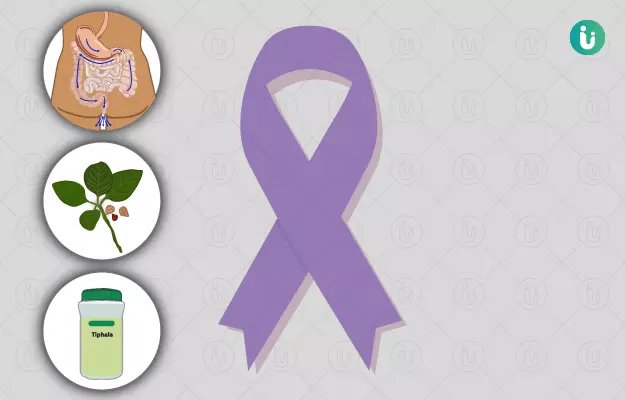There is no definitive term for cancer in Ayurvedic medicine. In Ayurveda, cancer was viewed as a swelling, which could be elevated or deep-rooted, often like that an ulcer. The ayurvedic term used to denote such swellings and lumps is arbuda and that is what we will be using to denote this condition in the rest of the article. Cancer generally develops slowly in the beginning; and in the early stages, it is usually less painful.
According to Ayurveda, cancer is caused due to vitiation of doshas, which in turn afflict the rakta and mamsa dhatus. Various dietary and environmental factors like regular consumption of unwholesome food, meat, tobacco chewing and smoking, chemical and mechanical irritants (sunlight and radiation), and use of certain medicines can cause cancer. Occupational exposure to carcinogens, and air and water pollution can also lead to cancer.
Ayurveda describes numerous treatments for cancer that include detoxification of body and removal of tumours. Treatments for arbuda include snehana (oleation), swedana (sudation or sweat therapy) like tapa (fomentation) and upanaha (application of hot poultice), virechana (purgation), basti (enema), raktamokshana (bloodletting), agni karma (thermal cauterization), kshara karma (cauterization with alkalies), and shastra karma (surgical therapy). Herbs used in the management of cancerous tumours are pippali (long pepper), guduchi (giloy), brahmi (waterhyssop), haridra (turmeric), ashwagandha (Indian ginseng) yashtimadhu (mulethi), etc. Some Ayurvedic medicines with herbomineral combinations that are used in cancer management are rudra rasa, triphala, kanchanara guggulu and mahamanjishthadi kwatha.
- Ayurvedic view of cancer
- Ayurvedic treatment for cancer
- Ayurvedic herbs and medicines for cancer
- Dietary and lifestyle changes for cancer patient as per ayurveda
- How effective are ayurvedic medicines and treatments for cancer
- Side effects and risks of ayurvedic medicine and treatments for cancer
- Takeaway
Ayurvedic view of cancer
Arbuda is one of the leading causes of death across the world which occurs due to the unwanted, and uncontrolled growth of cells anywhere in the body. It is a deep-seated, painless and non-suppurating mass in the initial stages. Although there have been great developments in the field of medicine, significant flaws are present in current therapeutic measures for cancer and, thereby, the scope for improvement is still there. Also, there are numerous side effects of the available treatment options of cancer like chemotherapy.
As per Ayurveda, cancer can be classified according to the dosha and tissue involved. Following are the different ways that cancer is classified in, according to Ayurveda:
- Vataja, pittaja and kaphaja arbuda are benign conditions caused due to vitiated vata, pitta, and kapha, respectively.
- Tridoshaja is a mixed type of a tumour occurring at any site.
- Depending on the affected dhatu, cancer can be of three types- Raktaja arbuda (affects blood), Mamsaja arbuda (tumour of muscle and soft tissue), and Medoja (cancer of the fat tissue).
- It is also classified on the basis of the site or organ affected like ear, eye, nose etc.
- Depending on the prognosis, it is classified as sadhya (curable) and asadhya (incurable).
These tumours can further be classified as malignant or benign tumours. Benign tumours are comparatively less harmful; however, it is necessary to begin therapy immediately in case of malignant tumours as these can be life-threatening.
Ayurvedic treatment for cancer
- Snehana
- It is a detoxification therapy that involves the application of warm medicated oil all over the body or at specific trouble spots.
- The oil loosens and eliminates toxins trapped in the skin and blood, thereby, helping in better management of cancer. As a result of this procedure, toxins from deeper tissues start moving towards the gastrointestinal tract. The oil also lubricates and protects tissues from damage as ama (toxins) enters the digestive tract.
- Various herbs are added to the oil, which helps in the elimination of snehana oil from the body, preventing its accumulation. Different oils are used in this procedure, based on the dosha involved in the condition.
- It is generally a 3- to 7-day therapy, which is not recommended in individuals with very weak or strong digestion as per Ayurveda and in those with diarrhoea or vomiting.
- Virechana karma
- In this process, various herbs like senna and rhubarb are used to induce purgation. It helps in clearing bowels and removing ama from body.
- Virechana facilitates removal of excess pitta from gall bladder, liver and small intestine. It is also useful in the management of kapha doshas, which presents itself in the form of excess bile, fat and phlegm.
- Removal of the ama and balancing of the doshas in the body can be helpful in the management of cancer.
- Light meals with rice and dal are suggested to be taken post-virechana therapy to restore lost nutrients in the body.
- It is not recommended in case of vata dosha as it weakens digestive fire. Virechana should also be avoided in those with ulcers of the rectum, pregnant women, and weak and debilitated individuals.
- Basti karma
- Basti is an Ayurvedic enema therapy. Unlike western enemas, which cleanse only the rectum and the end portion of the colon (sigmoid colon), basti karma treats the entire length of the colon, rectum and anus.
- It not only removes faeces but also eliminates ama from the body and helps in the management of many disorders like chronic constipation, cancer, gout, rheumatism, osteoporosis, Alzheimer’s disease and epilepsy.
- Basti should not be used for treating babies or people with diarrhoea, colon cancer, rectal bleeding, and polyps.
- Swedana
- Swedana is a type of steam treatment that makes an important part of panchakarma therapy in Ayurveda. During this procedure, exposure to medicated steam widens all the channels in the body, which helps ama to move back into the gastrointestinal tract and be removed from the body. It allows the clearing of ama from the skin and blood.
- Heat from swedana therapy helps in restoring the balance between vata and kapha and removes coldness and stiffness from the body. A balance between doshas and detoxification of the body can be a useful therapeutic modality for cancer.
- This therapy can also be performed locally on the affected part in the form of nadi sweda (fomentation with steam). Medicines like shigru (drumstick tree) and juice of meat are boiled, and their steam is used to provide heat to the affected area.
- There are different methods of performing swedana such as tapa, upanaha, ushma (application of steam) and dhara (pouring warm and medicated oil or decoction over the body). Tapa and upanaha are commonly used for the removal of ama from the body in individuals with cancer.
- Tapa
- Tapa procedure involves the application of heat on body or the affected part of the body using a metal object or a heated cloth.
- It is useful in the management of diseases of vata and kapha doshas.
- Upanaha
- It involves the application of hot poultice to the body before going to bed.
- The poultice is made with various combinations of herbs depending on the clinical condition of the patient. After the application of poultice, an oiled and heated cloth of wool or silk is wrapped around the body, and the person is allowed to sleep.
- It helps in reducing aggravated doshas and works best for the treatment of vata dosha disorders.
- Tapa
- Raktamokshana
- Raktamokshana is a detoxifying process involving the removal of toxic blood from various sites in the body and is thus useful in the management of cancer.
- It is also effective in obtaining immediate results in cases of pitta disorders like skin, liver and spleen disorders.
- It is useful in the management of vataja, pittaja, kaphaja and medoja tumours.
- Depending on the dosha involvement, cow’s horn, non-poisonous leeches and gourd are used for raktamokshana process. In the case of medoja tumours, raktamokshana is indicated after making an incision over the tumour.
- Agni karma and kshara karma
- Agni karma is the burning of the tumour mass with a heated instrument, whereas kshara karma is the burning and ligation of the tumour mass using a caustic substance.
- These treatments are used alone or in combination with surgical therapies. They are useful in the management of kaphaja tumours, medoja tumours and tumours that cannot be treated using other medical treatments.
- As it may not be possible to remove the entire tumour by a surgical procedure, agni karma and kshara karma are generally recommended after the surgery.
- Shastra karma
- If a tumour does not respond to any medical treatments, it is removed surgically. This procedure involves the complete removal of the tumour, which will prevent its recurrence. The surgical treatments involve chhedana (excision) or lekhana (excision with scraping).
- The spread of cancer to the other organs is prevented during the surgical procedure using metal tourniquets made up of iron, zinc, copper or lead. The mass is then destroyed with agni karma or kshara karma depending on the depth and the extent of the tumour.
Ayurvedic herbs and medicines for cancer
Ayurvedic Herbs for Cancer
- Pippali
- It acts on the respiratory, digestive and reproductive systems and has pain-relieving, anti-parasitic, carminative (reduces bloating) and expectorant (expels phlegm) properties.
- Pippali is useful in the management of numerous diseases like cold, cough, asthma, gout and sciatica. It removes ama from the body and boosts immune function, thereby, helping in the management of cancer.
- It should be used with caution as it increases pitta dosha.
- Guduchi
- Guduchi acts on the circulatory and digestive systems and has numerous therapeutic effects in the management of pitta diseases, acquired immune deficiency syndrome (AIDS), jaundice due to kapha, skin diseases, chronic malarial fever and cancer.
- It helps in strengthening the individual before and after chemotherapy.
- Brahmi
- Brahmi acts on the circulatory, digestive, respiratory, nervous, reproductive and excretory systems.
- It is the best rejuvenator for brain cells and nerves and is known to improve immune system functioning. Brahmi also increases the frequency of urination, which helps in eliminating ama from the body. These properties may be helpful in the management of cancer.
- It is also used in the treatment of conditions such as psoriasis and rheumatism.
- Haridra
- Haridra acts on the circulatory, digestive, respiratory and urinary systems and has antibacterial, carminative and anthelmintic effects.
- It serves as a healer of wounds, blood purifier and helps in blood formation. These activities indicate its usefulness in cancer.
- In addition to the management of cancer, it can be used for treating many other conditions such as chronic hepatitis, skin disorders, urinary diseases and chronic bronchial asthma.
- Ashwagandha
- Ashwagandha acts on the nervous, reproductive and respiratory systems.
- It serves as a rejuvenator and is one of the top immune-boosting herbs and brain tonics in Ayurveda. These properties improve its efficacy in managing cancer. Being a rejuvenating herb, ashwagandha is especially helpful in strengthening the body before and after a chemotherapy session.
- Also, it is useful in many other conditions like AIDS, memory loss, skin diseases, ulcers and rheumatic swellings.
To avail the benefits of Ashwagandha, buy Urjas Ashwagandha Tablet by myUpchar Ayurveda.
- Yashtimadhu
- Yashtimadhu acts on the digestive, nervous, excretory, respiratory and reproductive systems and has emetic, expectorant, laxative, sedative and demulcent effects.
- It purifies blood and nourishes the brain. It is useful in managing cancer, laryngitis, inflammation, sore throat and ulcers.
Ayurvedic Medicines for Cancer
- Mahamanjishthadi kwatha
- It has many ingredients such as manjishtha (Indian madder), moorva (jartor), kutaja (kurchi), guduchi, shunthi (dried ginger), kantakari (chhoti katheri), vacha (calamus), haridra, pippali and katuki (kutki).
- It is helpful in the management of diseases like visarpa (eczema) and kushtha (leprosy). Many ingredients in this kwatha are useful in the effective management of cancer due to their immunomodulatory and rejuvenating properties.
- Triphala
- It consists of three fruits, i.e., amalaki (Indian gooseberry), haritaki (chebulic myrobalan) and vibhitaki (belleric myrobalan). The ingredients of this formulation have rejuvenative, antibacterial, antifungal, antiviral and antimalarial properties.
- Triphala improves the absorption of nutrients in body and assists in improving metabolism. It is known to have antineoplastic (prevents tumour growth), chemoprotective and radioprotective effects, thus proving useful in the treatment of cancer and as an adjunct to chemotherapy and radiotherapy.
- Kanchanara guggulu
- It consists of kanchanara bark, triphala, trikatu (three acrids), varun bark, dalchini (cinnamon), ela (cardamom), tamalpatra (Indian bay leaf) and guggulu (Indian bdellium tree).
- As triphala is one of the medicines used to manage cancer and other ingredients in this formulation are also possess some anti-canncer properties, kanchanara guggulu is efficacious in cancerous conditions. In addition to this, it is also useful in the management of gandamala (inflammation of glands in the neck).
- Rudra rasa
- It is also called as arbudahara rasa and contains various ingredients like mercury and sulphur powdered with a decoction of betel leaf, punarnava (red hogweed), cow’s urine, long pepper and amaranthus.
- It is useful in the management of all types of cancers.
As treatments vary according to numerous factors and an individual’s prakriti (constitution), consult a qualified Ayurvedic doctor for the appropriate medications and treatments for your specific complaints.
Dietary and lifestyle changes for cancer patient as per ayurveda
Do’s
- Include vegetarian food in your diet.
- Include plenty of fruits in your diet.
- Live in a healthy surrounding.
- Observe mental peace.
Don’ts
- Do not eat processed food.
- Do not include meat in your diet.
- Do not drink contaminated and polluted water.
- Avoid living in a polluted surrounding. Keep your surroundings clean.
- Avoid smoking cigarettes, eating tobacco and drinking alcohol. (Read more: How to quit alcohol)
How effective are ayurvedic medicines and treatments for cancer
A study was conducted to identify the effects of turmeric on colorectal cancer, which is the second leading cause of cancer-related deaths in the world. The study stated that there is no effective treatment for colorectal cancer except resection in the initial stage with or without chemotherapy. As curcumin is one of the active chemical constituents of turmeric and is found to be useful in the management of cancer in most of the clinical studies conducted in the past, this study involved 15 participants with colorectal cancer and assess the effects of turmeric on these individuals. Turmeric was found to be well-tolerated and effective in cancer management along with other treatment measures like chemotherapy.
Other studies indicated the effectiveness, safety and tolerance of curcumin in participants with advanced pancreatic cancer, breast cancer, multiple myeloma, prostate cancer, lung cancer and cancer lesions. This indicates the wide range of effectiveness of turmeric in the management of cancer.
Side effects and risks of ayurvedic medicine and treatments for cancer
Although the side effects of the herbs and medicines described above are not like that of chemotherapy, correct use of these medicines is the primary requirement for a positive output. Necessary precautions should be observed before using these natural herbs and the associated risks should not be ignored, e.g., long pepper causes a rise in the pitta dosha, while mulethi should be used with caution in kapha excess and avoided in pregnant women.
Takeaway
Cancer is one of the leading causes of death all over the world, and although its treatment is challenging, the right treatment and appropriate care can help in managing this condition. Ayurveda describes numerous procedures, herbs and medicines that can help in better and effective management of cancer. Chemotherapy, commonly used in the treatment of cancer, causes numerous side effects. A combination of Ayurveda and modern medicine can help in the effective control of cancer, its symptoms, and the side effects caused due to the current treatment measures.
Although Ayurvedic treatments include natural herbs, it should always be used after consulting an Ayurvedic physician to avoid any side effects and for better management of the condition.
Find Ayurvedic Doctor in cities
Doctors for Ayurvedic medicine, treatment and remedies for Cancer

Dr. Ayush Bansal
Ayurveda
2 Years of Experience

Dr. Megha Sugandh
Ayurveda
6 Years of Experience

Dr. Nadeem
Ayurveda
3 Years of Experience

Dr.Ashok Pipaliya
Ayurveda
12 Years of Experience
References
- National Institute of Indian Medical Heritage (NIIMH). Arbuda. Central Council for Research in Ayurvedic Sciences (CCRAS); Ministry of AYUSH, Government of India.
- Kavita Rathiya. A Conceptual Study On Arbuda (Cancer) And Its Management: A Review. International Journal of Ayurveda and Pharma Research, Vol 6, Issue 6: June 2018.
- Lakshmi Chandra Mishra. Scientific Basis for Ayurvedic Therapies. International Ayurvedic Medical Journal, 2004.
- Roopesh Jain, Susmit Kosta, Archana Tiwari. Ayurveda and cancer. Pharmacognosy Res. 2010 Nov-Dec; 2(6): 393–394, PMID: 21713145.
- Avni G. Desai. Medicinal Plants and Cancer Chemoprevention. Curr Drug Metab. Author manuscript; available in PMC 2014 Sep 11, PMID: 18781909.
- Baliga MS. Triphala, Ayurvedic formulation for treating and preventing cancer: a review.. J Altern Complement Med. 2010 Dec;16(12):1301-8, PMID: 21138390.
- Rajiv Gandhi Government Post Graduate Ayurvedic College. Kayachikitsa. Paprola, Himachal Pradesh. [Internet].
- Subash C. Gupta, Sridevi Patchva, Bharat B. Aggarwal. Therapeutic Roles of Curcumin: Lessons Learned from Clinical Trials. AAPS J. 2013 Jan; 15(1): 195–218, PMID: 23143785.














